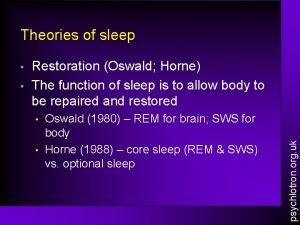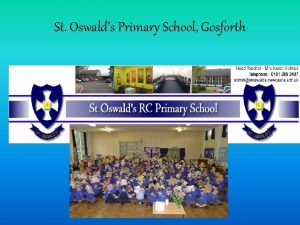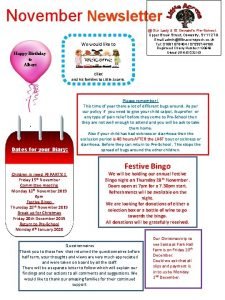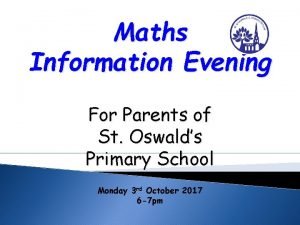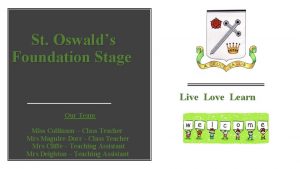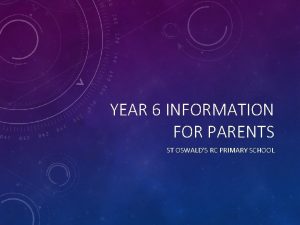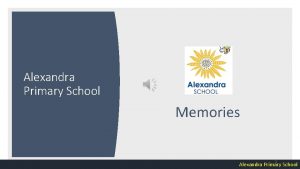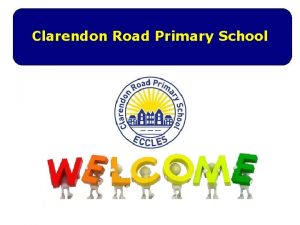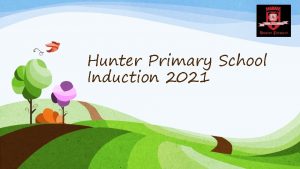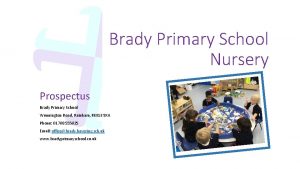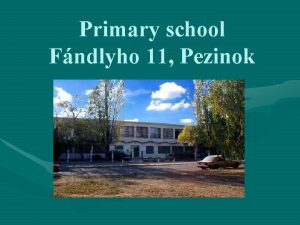St Oswalds C E Primary School Reading for





















- Slides: 21

St. Oswald’s C. E. Primary School Reading for Inference Wednesday 27 th September 2017 Holly Massey-English Leader Michelle Dawson-Key Stage 2 Teacher

The National Curriculum-overview Reading and Writing ”…should develop pupils’ reading and writing in all subjects to support their acquisition of knowledge. Pupils should be taught to read fluently, understand extended prose (both fiction and non-fiction) and be encouraged to read for pleasure. Schools should do everything to promote wider reading. They should provide library facilities and set ambitious expectations for reading at home. ” Vocabulary Development “Pupils’ acquisition and command of vocabulary are key to their learning and progress across the whole curriculum. Teachers should therefore develop vocabulary actively, building systematically on pupils’ current knowledge. They should increase pupils’ store of words in general; simultaneously, they should also make links between known and new vocabulary and discuss the shades of meaning in similar words. ” “In addition, it is vital for pupils’ comprehension that they understand the meanings of words they meet in their reading across all subjects. ”

English Curriculum-reading “Good comprehension draws from linguistic knowledge (in particular of vocabulary and grammar) and on knowledge of the world. Comprehension skills develop through pupils’ experience of high-quality discussion with the teacher, as well as from reading and discussing a range of stories, poems and non-fiction. ” “All pupils must be encouraged to read widely across both fiction and nonfiction to develop their knowledge of themselves and the world in which they live, to establish an appreciation and love of reading, and to gain knowledge across the curriculum. Reading widely and often increases pupils’ vocabulary because they encounter words they would rarely hear or use in everyday speech. ” “Reading also feeds pupils’ imagination and opens up a treasure-house of wonder and joy for curious young minds. It is essential that, by the end of their primary education, all pupils are able to read fluently, and with confidence, in any subject in their forthcoming secondary education. ”

How we teach reading at St. Oswald’s • We teach reading from the very start of reception, initially through phonics, building CV and CVC words using sounds that they have been taught. • As children’s phonics & sight vocabulary knowledge increases they are able to read increasingly longer texts. • All children read individually in class with an adult during the week, at least once and in Key Stages 1 & 2 children read in a group with a teacher once a week, working on comprehension skills. • Children are given the opportunity to share texts with their peers throughout the week during Library, ERIC and Reading Buddy time.

Year 1 Reading Comprehension statutory requirements Develop pleasure in reading, motivation to read, vocabulary and understanding by: • Listening to and discussing a wide range of poems, stories and non-fiction at a level beyond that at which they can read independently. • Being encouraged to link what they read or hear read to their own experiences. • Becoming very familiar with key stories, fairy stories and traditional tales, retelling them and considering their particular characteristics. • Recognising and joining in with predictable phrases. • Learning to appreciate rhymes and poems, and to recite some by heart. • Discussing word meanings, linking new meanings to those already known. Understand both the books they can already read accurately and fluently and those they listen to by: • Drawing on what they already know or on background information and vocabulary provided by the teacher. • Checking that the text makes sense to them as they read and correcting inaccurate reading. • Discussing the significance of the title and events. • Making inferences on the basis of what is being said and done. • Predicting what might happen on the basis of what has been read so far. • Participate in discussion about what is read to them, taking turns and listening to what others say. • Explain clearly their understanding of what is read to them.

Year 2 Reading Comprehension statutory requirements Develop pleasure in reading, motivation to read, vocabulary and understanding by: • Listening to, discussing and expressing views about a wide range of contemporary and classic poetry, stories and non-fiction at a level beyond that at which they can read independently. • Discussing the sequence of events in books and how items of information are related. • Becoming increasingly familiar with and retelling a wider range of stories, fairy stories and traditional tales. • Being introduced to non-fiction books that are structured in different ways. • Recognising simple recurring literary language in stories and poetry. • Discussing and clarifying the meanings of words, linking new meanings to known vocabulary. • Discussing their favourite words and phrases. • Continuing to build up a repertoire of poems learnt by heart, appreciating these and reciting some, with appropriate intonation to make the meaning clear. Understand both the books that they can already read accurately and fluently and those that they listen to by: • Drawing on what they already know or on background information and vocabulary provided by the teacher. • Checking that the text makes sense to them as they read and correcting inaccurate reading. • Making inferences on the basis of what is being said and done. • Answering and asking questions. • Predicting what might happen on the basis of what has been read so far. • Participate in discussion about books, poems and other works that are read to them and those that they can read for themselves, taking turns and listening to what others say. • Explain and discuss their understanding of books, poems and other material, both those that they listen to and those that they read for themselves.

Year 3/4 Reading Comprehension statutory requirements Develop positive attitudes to reading and understanding of what they read by: • Listening to and discussing a wide range of fiction, poetry, plays, non-fiction and reference books or textbooks. • Reading books that are structured in different ways and reading for a range of purposes. • Using dictionaries to check the meaning of words that they have read. • Increasing their familiarity with a wide range of books, including fairy stories, myths and legends, and retelling some of these orally. • Identifying themes and conventions in a wide range of books. • Preparing poems and play scripts to read aloud and to perform, showing understanding through intonation, tone, volume and action. • Discussing words and phrases that capture the reader’s interest and imagination. • Recognising some different forms of poetry [for example, free verse, narrative poetry] Understand what they read, in books they can read independently, by: • Checking that the text makes sense to them, discussing their understanding and explaining the meaning of words in context. • Asking questions to improve their understanding of a text. • Drawing inferences such as inferring characters’ feelings, thoughts and motives from their actions, and justifying inferences with evidence. • Predicting what might happen from details stated and implied. • Identifying main ideas drawn from more than one paragraph and summarising these. • Identifying how language, structure, and presentation contribute to meaning. • Retrieve and record information from non-fiction. • Participate in discussion about both books that are read to them and those they can read for themselves, taking turns and listening to what others say.

Year 5/6 Reading Comprehension statutory requirements Maintain positive attitudes to reading and understanding of what they read by: • Continuing to read and discuss an increasingly wide range of fiction, poetry, plays, non-fiction and reference books or textbooks. • Reading books that are structured in different ways and reading for a range of purposes. • Increasing their familiarity with a wide range of books, including myths, legends and traditional stories, modern fiction, fiction from our literary heritage, and books from other cultures and traditions. • Recommending books that they have read to their peers, giving reasons for their choices. • Identifying and discussing themes and conventions in and across a wide range of writing. • Making comparisons within and across books. • Learning a wider range of poetry by heart. • Preparing poems and plays to read aloud and to perform, showing understanding through intonation, tone and volume so that the meaning is clear to an audience. Understand what they read by: • Checking that the book makes sense to them, discussing their understanding and exploring the meaning of words in context. • Asking questions to improve their understanding. • Drawing inferences such as inferring characters’ feelings, thoughts and motives from their actions, and justifying inferences with evidence. • Predicting what might happen from details stated and implied. • Summarising the main ideas drawn from more than one paragraph, identifying key details that support the main ideas. • Identifying how language, structure and presentation contribute to meaning. • Discuss and evaluate how authors use language, including figurative language, considering the impact on the reader. • Distinguish between statements of fact and opinion. • Retrieve, record and present information from non-fiction. • Participate in discussions about books that are read to them and those they can read for themselves, building on their own and others’ ideas and challenging views courteously. • Explain and discuss their understanding of what they have read, including through formal presentations and debates, maintaining a focus on the topic and using notes where necessary. • Provide reasoned justifications for their views.




Looking more closely at Inference What is inference? Inference is where we ‘read between the lines’ to gain a greater understanding of what we are looking at and to reach logical conclusions.

Direct Questions The answers are right there in the text. This is an example from last years KS 1 SATS reading paper. Just in time, he heard someone singing. Fox dashed off the path and hid behind a bush. Find and copy one word that shows that Fox moved quickly.

Direct Questions The answers are right there in the text. This is an example from last years KS 1 SATS reading paper. Just in time, he heard someone singing. Fox dashed off the path and hid behind a bush. Find and copy one word that shows that Fox moved quickly.

Inference Questions The answers are found by reading ‘between the lines’ in the text. This is an example from last years KS 1 SATS reading paper. The story shows that Heron Feather was. . . Tick one Truthful foolish very brave hard-working

Inference Questions The answers are found by reading ‘between the lines’ in the text. This is an example from last years KS 1 SATS reading paper. The story shows that Heron Feather was. . . Tick one Truthful foolish very brave hard-working

Direct Questions The answers are right there in the text. This is a question from an example KS 2 SATS reading paper. Every mouse needs somewhere to live. It might seem obvious but your mouse’s cage will be where it spends most of its time, so it needs to be large and secure. It must also have an adequate air flow as mice have sensitive lungs and frequently develop breathing problems. Ensure that the cage is positioned in a peaceful location, as mice doze through the day and are easily startled. Give one reason why a mouse’s cage should be placed somewhere quiet.

Direct Questions The answers are right there in the text. This is a question from an example KS 2 SATS reading paper. Every mouse needs somewhere to live. It might seem obvious but your mouse’s cage will be where it spends most of its time, so it needs to be large and secure. It must also have an adequate air flow as mice have sensitive lungs and frequently develop breathing problems. Ensure that the cage is positioned in a peaceful location, as mice doze through the day and are easily startled. Give one reason why a mouse’s cage should be placed somewhere quiet.

Inference Questions The answers are found by reading ‘between the lines’ in the text. This is a question from an example KS 2 SATS reading paper. Meandering along a side street, we heard the din of the traditional market long before we could see it. We turned a corner near the canal and I was taken aback. The wide square was alive: traders laughed and argued, food steamed and filled the air with mouth-watering smells and the cobbles were bustling with people. I had to constantly dive out of the paths of determined shoppers. One stall displayed numerous pieces of delicate jewellery. Mum bought me a silver bracelet with round lilac gemstones nestled in it. Another sold sweetly fragranced tulips in an unbelievable range of colours. What do you think Sophie’s opinion of the market was? Explain your answer using evidence from the text.

Inference Questions The answers are found by reading ‘between the lines’ in the text. This is a question from an example KS 2 SATS reading paper. Meandering along a side street, we heard the din of the traditional market long before we could see it. We turned a corner near the canal and I was taken aback. The wide square was alive: traders laughed and argued, food steamed and filled the air with mouth-watering smells and the cobbles were bustling with people. I had to constantly dive out of the paths of determined shoppers. One stall displayed numerous pieces of delicate jewellery. Mum bought me a silver bracelet with round lilac gemstones nestled in it. Another sold sweetly fragranced tulips in an unbelievable range of colours. What do you think Sophie’s opinion of the market was? Explain your answer using evidence from the text.

Top Reading Tips Ø Take time to read different types of texts; newspapers, magazines, nonfiction books, leaflets, visit the library…even cereal boxes! Ø Allow your child to read a page of their text independently and then ask them a few key questions to see if they can deduce and infer from the text. Ø Mix it up-Questions don’t always need to be inference based, good old direct and retrieval questions are always important to gauge understanding. Especially with new vocabulary. Ø Most importantly…enjoy it!
 Oswalds theory of restoration
Oswalds theory of restoration Pre reading while reading and post reading activities
Pre reading while reading and post reading activities Japanese private school uniform
Japanese private school uniform Fspos vägledning för kontinuitetshantering
Fspos vägledning för kontinuitetshantering Novell typiska drag
Novell typiska drag Tack för att ni lyssnade bild
Tack för att ni lyssnade bild Returpilarna
Returpilarna Shingelfrisyren
Shingelfrisyren En lathund för arbete med kontinuitetshantering
En lathund för arbete med kontinuitetshantering Adressändring ideell förening
Adressändring ideell förening Personlig tidbok
Personlig tidbok A gastrica
A gastrica Vad är densitet
Vad är densitet Datorkunskap för nybörjare
Datorkunskap för nybörjare Tack för att ni lyssnade bild
Tack för att ni lyssnade bild Debattartikel mall
Debattartikel mall För och nackdelar med firo
För och nackdelar med firo Nyckelkompetenser för livslångt lärande
Nyckelkompetenser för livslångt lärande Påbyggnader för flakfordon
Påbyggnader för flakfordon Kraft per area
Kraft per area Svenskt ramverk för digital samverkan
Svenskt ramverk för digital samverkan Jag har gått inunder stjärnor text
Jag har gått inunder stjärnor text
